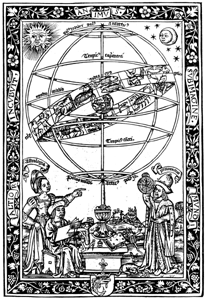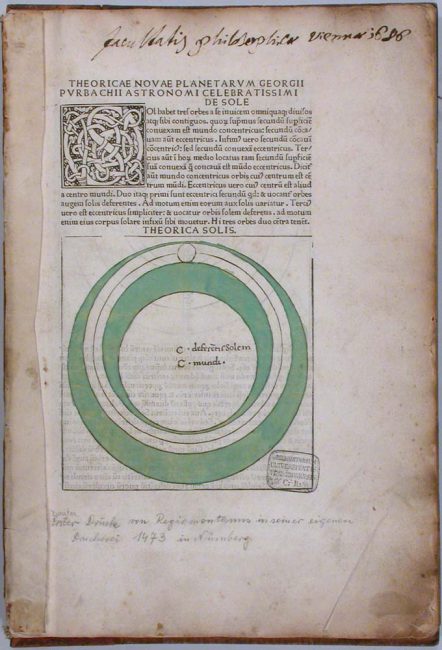
Georg von Peuerbach: Theoricarum novarum planetarum testus, 1515
On May 30, 1423, Austrian astronomer, mathematician and instrument maker Georg von Peuerbach was born. He is best known for his streamlined presentation of Ptolemaic Astronomy in the Theoricae Novae Planetarum. Furthermore, he promoted the use of Arabic numerals (introduced 250 years earlier in place of Roman numerals), especially in a table of sines he calculated with unprecedented accuracy.
Not much is known about Peuerbach’s Early Life
There is not much known about Peuerbach’s early life. However, he probably entered the University of Vienna in 1446, when he was already 23 years old. It is believed that he spent much time traveling through Italy prior to his formal education at Vienna. There, it took him two years to earn his Bachelor degree and in 1448. It is assumed that most of his studies contained humanities courses. His teacher Johannes von Gmunden was, like Peuerbach himself, an important representative of the Vienna astronomical school. Von Gmunden then recommended him to the University of Padua, where he gave astronomical lectures in 1449. Subsequently Peuerbach even received a (as usual one year) professorship at the University of Bologna and in 1450 in Ferrara. There he met the famous mathematicians and astronomers Giovanni Bianchini and Toscanelli. He turned down Bianchini’s offer of a chair and went to Rome, Regarding his knowledge on astonomy, it has not quite become clear where he received his knowledge from. Peuerback apparently began teaching astronomy and mathematics and worked together with Johann von Gmunden, himself an astronomer, mathematician, humanist and early instrument maker.
Astrologer of King Ladislaus V of Hungary
Probably in 1454, Georg von Peuerbach was appointed court astrologer by King Ladislaus V of Hungary and of Bohemia, who was only 14 years old at the time. Ladislaus spent most of his time in Prague and Vienna and Peurbach was able to also teach at the University of Vienna, where he obtained the licentiate in 1452 and the Magister artium in 1453. However, it is possible that his teaching was mostly in humanities instead of astronomy. After the unfortunate death of the young leader, Peuerbach was appointed as court astrologer to the Holy Roman emperor Frederick III. Frederick was mostly interested in astrology, magic, and alchemy.
Ptolemy’s Astronomy and Regiomontanus
To one of Peuerbach’s most important students at the University of Vienna also belongs Regiomontanus [4] who graduated at the age of 15 and started working together with the scientist afterwards for a period of several years. Their working relationship was very fruitful. Peuerbach recognised the shortcomings of the Ptolemaic system and began a revision of the main Ptolemaic script Almagest, the standard work of the time. In contrast to Sacrobosco, he began a new translation of the Greek original and not the Arabic translation. In 1460 the papal envoy Cardinal Bessarion came to Vienna. He commissioned Peuerbach to explain the Almagest. With his pupil Regiomontanus, who had come to Vienna in 1450 to study, he began writing the Epitomes for the Almagest, which he completed after Peuerbach’s early death.
Theoreticae Novae Planetarum
Peuerbach’s lectures on planetary movements at the University of Vienna, which were still based on Ptolemaic teachings, became so famous that from 1472 they were printed under the title ‘Theoricae Novae Planetarum‘. In it, Peuerbach attempted to present Ptolemy’s astronomy in a more elementary and comprehensible way. He believed that the planets were in solid crystalline spheres although he believed that their motions were controlled by the Sun. It turned out a great success and soon managed to become a standard work for teaching astronomy. Further, Peuerbach made several significant advances to the field of mathematics including his contributions to the sine tables, the observations of comets and instrument building. Together with Regiomontanus, Peuerbach carried out measurements of occultations of planets by the moon and lunar eclipses in order to verify the astronomical tables.

Georg von Peuerbach: “Theoricae novae planetarum”, 1473
Astronomical Instruments
Peuerbach was also engaged in astronomical observations and the construction of astronomical instruments. He produced instruments for determining the true new and full moons, the most important of which are the inventions of the ring and folding sundial. Thus he had determined the shape of the sundial until the 18th century. In 1451 he constructed a vertical sundial for St. Stephen’s Cathedral of Vienna. In 1456 Halley’s Comet appeared and all astrologers published writings with predictions of coming doom, including Peuerbach. However, his writing contained a short, unnoticed paragraph in which he tried to estimate the size and distance of the comet from his observations on June 9 and 13. On September 3, 1457 Peuerbach and Regiomontanus observed a lunar eclipse in Melk. To determine the time they measured the elevation angle of the Pleiades star Alkione. To check the eclipse tables Tabulae eclipsium calculated in 1459 they observed the lunar eclipses of the year 1460. On the other hand, the planet words deviated strongly from the calculations. Peuerbach began to work out correction terms for the Alfonsine Tables, but he could not finish the work.
At the Beginning of the Scientific Revolution
Georg von Peuerbach stood at the beginning of the scientific revolution of the early modern age; this revolution came to an end with the new world system of Nicolaus Copernicus [6] and Johannes Kepler.[7] In the 15th century, the planetary movement according to Ptolemy and his epicycle theory was intensively discussed and improvements were sought. This was necessary on the one hand because the solar year had moved further and further away from the Julian calendar and required a calendar reform, and on the other hand more accurate “star books” were necessary for ship navigation. Due to both requirements, observational astronomy was revived at that time, and this was embodied by Peuerbach.
Georg von Peuerbach died in 1461. It is believed that during his lifetime, he had a close and romantic relationship to a monk who is said to have committed suicide. Peuerbach then wrote several poems in the name of his love in Latin in order to honor his partner.
Andrew Harrison, How do we know the Earth goes around the Sun?: Laws of Physics lecture, [11]
References and Further Reading:
- [1] The astronomical revolution didn’t start here! at The Renaissance Mathematicus
- [2]John J. O’Connor, Edmund F. Robertson: Georg von Peuerbach. In: MacTutor History of Mathematics archive.
- [3] Georg von Peuerbach at Wikidata
- [4] Regiomontanus – Forerunner of Modern Astronomy, SciHi Blog
- [5] The astronomical revolution didn’t start here!, The Renaissance Mathematicus, May 30, 2011.
- [6] Nicolaus Copernicus and the Heliocentric Model, SciHi Blog
- [7] And Kepler Has His Own Opera – Kepler’s 3rd Planetary Law, SciHi Blog
- [8] Tractatus Georgii Peurbachii Super Propositiones Ptolemaei de Sinubus & Chordis. Norimbergae 1541
- [9] Ioannis De Monte Regio Et Georgii Purbachii Epitome, In Cl. Ptolemaei Magnam compositionem. Basileae 1543
- [10] Electronic Facsimile Editions of the Book Collection of the University Observatory Vienna
- [11] Andrew Harrison, How do we know the Earth goes around the Sun?: Laws of Physics lecture, 2013, University of Essex @ youtube
- [12] Timeline of medieval astronomers, via DBpedia and Wikidata






Pingback: Whewell’s Gazette: Vol. #49 | Whewell's Ghost
Given that Johann von Gmunden died before Georg von Peuerbach enrolled as a student in Vienna it is highly unlikely that they “worked together”!
Pingback: Whewell’s Gazette: Year 3, Vol. #42 | Whewell's Ghost